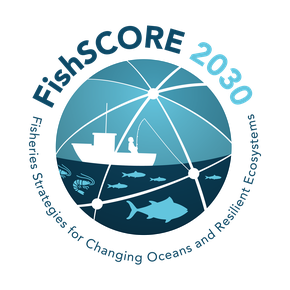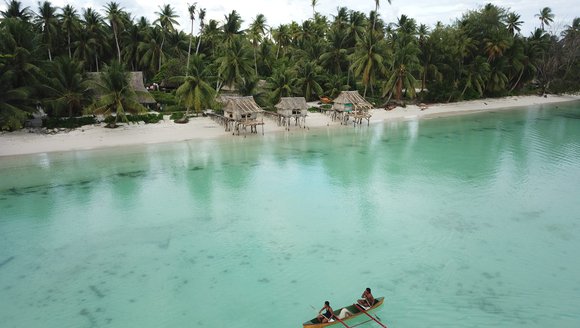Climate Change and Fisheries Systems
Transforming fisheries in the face of climate change.
Climate change is causing direct, indirect, and cascading impacts on marine social-ecological systems, including fisheries, with the intensity, frequency, extent, and duration of these impacts increasing. As fisheries experience climate change, harvesters, seafood supply chain actors, fishery managers, fishing communities, and others are acting to prepare for, resist, cope with, recover from, or adapt to climate impacts. Photo credit: Jacob Eurich.

Key Points:
- The oceans are absorbing excess heat and carbon from the atmosphere, leading to changes in ocean temperature, circulation patterns, and chemistry as well as sea level rise and increased storm surges on the coastlines.
- These physical changes affect the distribution, abundance, and health of certain marine species, and they impact fishing practices and shoreside infrastructure.
- Fishery systems are affected by these ecological changes as well as by compounding climate challenges for shoreside processors and businesses, coastal communities, and food systems.
Fisheries operate at the intersection of oceans and societies, and future fisheries will be shaped by direct, indirect, and cascading impacts of climate change. Climate impacts affect marine ecosystems and fished species, physical infrastructure, social networks, and governance and market systems that support marine fisheries—thereby threatening people and communities that rely on the oceans for food, livelihoods, cultural traditions, and well-being. As fisheries experience climate change, harvesters, seafood supply chain actors, fishery managers, fishing communities, and others are recognizing the need to prepare by building resilience to current and future impacts.
How Climate Change is Impacting Marine Fisheries and Social-Ecological Systems
The impacts of climate change on the oceans are many, from ocean acidification and changes in salinity and circulation to increased temperatures and harmful algal blooms. These impacts affect where marine species are found and their health. For example, many species are shifting their distributions towards the poles and into deeper waters in search of their preferred temperature, maturing at smaller sizes, and becoming more vulnerable to pathogens and disease.
In turn, marine fisheries are altered at individual, community, and larger scales. The impacts of changing conditions on marine species can reduce the types of species accessible to fishers and the composition of their catch. As species move, fishers may travel farther to reach their fishing grounds or risk more difficult fishing situations with smaller catches. These difficulties can be compounded by the increasing frequency and severity of storms due to climate change, exposing fishers to potentially more dangerous ocean conditions. Finally, marine species distributions may shift beyond jurisdictions, restricting fishers from accessing the species they have historically caught due to management regulations.
While new species whose ranges have expanded may become accessible, fishers may not have the right gear or permits for catching these species, and shoreside businesses may not have the expertise to process, store, and distribute them. Additionally, shoreside infrastructure, including landing ports and processing businesses, seafood retailers and restaurants, as well as homes and community stores, may be at risk of flooding from sea level rise and storm surges. These compounding issues can impact seafood economies, food security, and community stability at the local and regional scales.

Impacts of climate change on fisheries and aquaculture
For more information, please see the "Impacts of climate change on fisheries and aquaculture: Synthesis of current knowledge adaptation and mitigation options" report, developed by the Food and Agriculture Organization of the United Nations (FAO) as a comprehensive synthesis of the issues facing fisheries and aquaculture and their economies due to climate change.
As climate change impacts are being realized, many fisheries around the world face immediate needs to (1) understand how climate change is impacting their fishery systems now and in the future; (2) evaluate how resilience-supporting features are currently functioning and may be affected by future changes; (3) assess resilience limitations and barriers; and (4) identify strategies and pathways that can be operationalized to support climate resilience in the fishery.
Marine fisheries will benefit from diverse sources of knowledge and accessible data, local experience, predictive models and locally-relevant, forward-looking information, and scalable resilience planning approaches. The ability to understand and plan for climate resilience in ways that engage diverse participants will be important for identifying transformative pathways to sustain fishery resources, provide food and income for communities, and ensure greater equity in sharing responsibilities and benefits associated with marine ecosystems and fisheries.
Changes in marine ecosystems and the impacts on fished species have cascading effects on fishers, marine resource dependent communities, their economies, and how these systems are managed. Ecological, social, economic, policy, and cultural conditions all must be considered, and they provide a basis for assessing potential resilience.

These resilience attributes can function across multiple levels of fisheries, including how harvesters operate their fishing businesses, management measures that affect the fishery, community-based resources such as shoreside businesses and transportation networks that directly support fisheries, as well as social networks, learning opportunities, and other community features.
These influences also span multiple spatial and temporal scales. For example, harvesters must make fishing and business decisions based on relatively short-term local conditions; management measures may consider fishery expectations over several years and over the extent of the fishery’s range; and communities typically need to plan for infrastructure investments over several decades.
Recent research incorporates these factors and timescales in practice by systematically assessing the resilience attributes across diverse case studies. This research explicitly links the resilience attributes to social-ecological outcomes to identify approaches, pathways, and actionable levers for improving climate resilience in fishery systems.

Return to the FishSCORE2030 home page.
Coordination Group
Upcoming FishSCORE2030 Events
Read More
-
![FishSCORE2030: Supporting Climate-Resilience in Fisheries]()
FishSCORE2030: Supporting Climate-Resilience in Fisheries
GMRI Research Scientist Dr. Kathy Mills is leading a new collaborative effort to build an international network of scientists, stakeholders, and practitioners who will identify …
Tidings
-
![Supporting climate-resilient fisheries during the UN Decade of Ocean Science]()
Supporting climate-resilient fisheries during the UN Decade of Ocean Science
Press Clips
-
![GMRI Scientist Awarded Prestigious CINAR Fellowship]()
GMRI Scientist Awarded Prestigious CINAR Fellowship
Senior Research Scientist Dr. Kathy Mills is one of four researchers awarded the CINAR Fellowship in Quantitative Fisheries and Ecosystem Science.
Announcements
-
![New: Climate & Fisheries Planning Tool]()
New: Climate & Fisheries Planning Tool
The Science for Nature and People Partnership (SNAPP) working group on climate-resilient fisheries, led by GMRI Senior Research Scientist Dr. Kathy Mills, recently developed a …
Tidings



